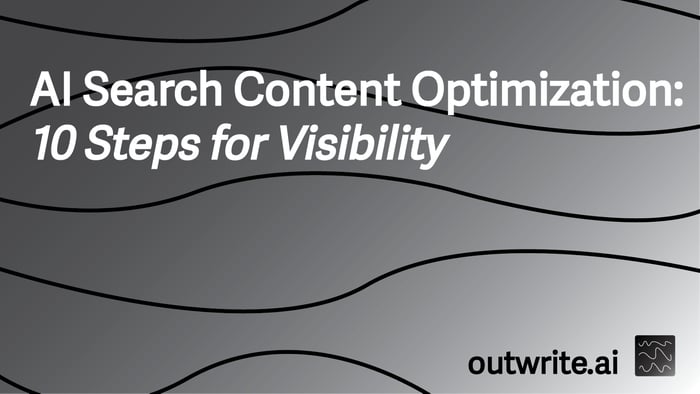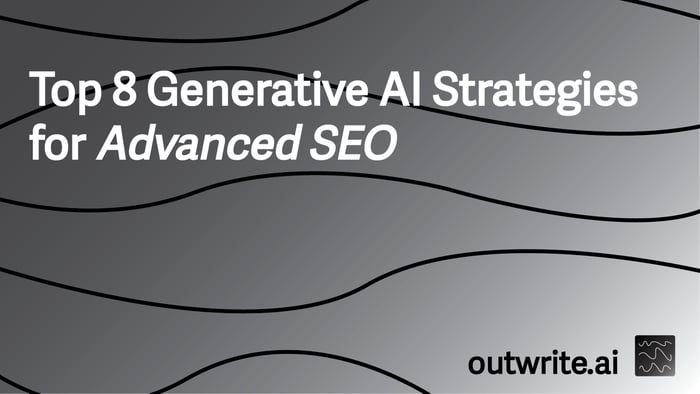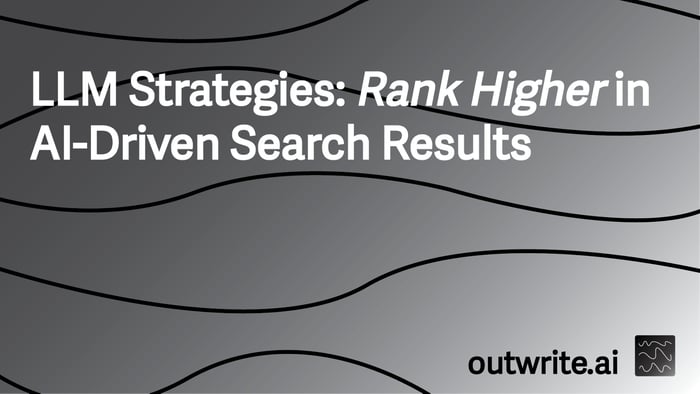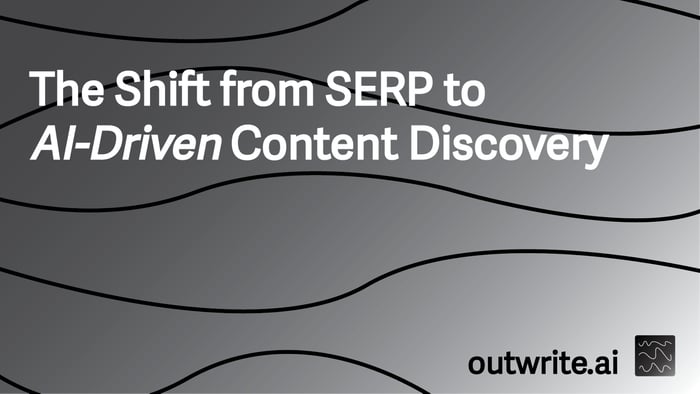Table of Contents
- Step 1: Master AI-Driven Search Intent
- Step 2: Embrace Content Chunking and Modularity
- Step 3: Implement Advanced Schema Markup
- Step 4: Leverage Generative AI with Human Oversight
- Step 5: Prioritize Rapid Content Creation for AI Queries
- Step 6: Build Authority Through Thought Leadership
- Step 7: Optimize for AI Overviews and Direct Answers
- Step 8: Continuously Monitor AI Search Performance
- Step 9: Structure Content with Q&A Formats
- Step 10: Integrate AI Tools for Keyword Research & Content Generation
- Conclusion: Seize Your AI Search Advantage
- FAQs
The landscape of search engine optimization (SEO) is undergoing a seismic shift, driven by the rapid evolution of AI technology. With Google AI Overviews (AIOs) now appearing in over 50% of all Google search results across devices as of mid-2025, the way users find information and the way search engines deliver it has fundamentally changed. This isn't just an incremental update; it's a complete re-architecture of search, demanding a proactive and intelligent approach to content optimization. Ignoring this shift means risking significant drops in visibility and traffic, as traditional SEO tactics alone are no longer sufficient to secure top rankings. Brands and content creators must adapt their strategies to cater to AI-driven search, or risk being left behind in an increasingly competitive digital environment.
This comprehensive guide provides a 10-step checklist for optimizing your content for AI search, ensuring your brand remains visible, authoritative, and highly recommended in the age of AI. We'll delve into actionable strategies, supported by real-world data and expert insights, to help you navigate the complexities of AI technology trends and secure your position at the forefront of search. From understanding AI-driven intent to leveraging advanced schema markup and AI technology solutions, each step is designed to maximize your content's potential for discovery by both human users and sophisticated AI algorithms. The future of SEO is here, and it demands a strategic embrace of AI technology best practices.
Step 1: Master AI-Driven Search Intent
Understanding and precisely matching search intent is no longer just a best practice; it's a critical requirement for AI search content optimization. AI models, particularly those powering Google AI Overviews, are highly adept at discerning the true underlying need behind a user's query. Content that directly and comprehensively addresses this intent is significantly more likely to be featured in AI-generated summaries and direct answers. This means moving beyond simple keyword matching to a deeper analysis of user questions, problems, and desired outcomes.
For example, if a user searches for "best noise-canceling headphones for travel," an AI-optimized piece of content wouldn't just list headphones; it would compare features relevant to travel (battery life, portability, comfort for long flights), discuss specific use cases (blocking airplane engine noise, office distractions), and perhaps even offer advice on what to look for in a travel headphone. This holistic approach ensures the content satisfies the user's intent fully, making it an ideal candidate for AI summarization. As Michal Suski, Head of Innovation at Surfer SEO, emphasizes, "Matching search intent is crucial… content closely matching query intent is far more likely to be chosen by Google’s AI answers."
To master AI-driven search intent, consider these approaches:
- Analyze AI Overviews: When AIOs appear for your target keywords, study the content they summarize. What questions do they answer? What sources do they cite? This provides direct insight into what AI considers authoritative and relevant.
- Deep Dive into User Questions: Utilize tools that analyze "People Also Ask" sections, forums, and social media to uncover the full spectrum of questions related to your keywords. Address these explicitly within your content.
- Categorize Intent Types: Differentiate between informational, navigational, transactional, and commercial investigation intent. Tailor your content structure and depth to match each specific intent type. For instance, a transactional query might require a product comparison table and clear calls to action, while an informational query needs detailed explanations and examples.
A successful case study by Surfer SEO demonstrated this principle. By creating a highly targeted page on "best free AI detectors" that precisely matched a niche search intent, they achieved citation in Google’s AI answers within just 8 hours. This rapid recognition underscores the power of intent alignment in the AI search era. This level of precision in content strategy is what AI technology solutions are built to reward.
Step 2: Embrace Content Chunking and Modularity
For AI models to efficiently process and extract information, content must be structured in a way that allows for easy parsing and summarization. This is where content chunking and modular writing become indispensable. Instead of long, unbroken paragraphs, break your content into smaller, self-contained sections, each addressing a distinct subtopic or question. This approach makes your content highly digestible for both AI and human readers, increasing its chances of being selected for AI Overviews or direct answers.
Bee By Clark Meyler advises to "write in modular, self-contained chunks that address distinct subtopics or questions," and to phrase headings as questions. This strategy directly optimizes for micro-answer extraction by AI. Each chunk should be able to stand alone as a valuable piece of information, making it easier for AI to pull out specific facts or answers without needing to process the entire article. This is a new standard for AI-friendly content, enabling specific paragraphs to be featured as direct answers, significantly boosting visibility.
Key aspects of effective content chunking include:
- Use Clear Headings and Subheadings: Employ H2, H3, and H4 tags to logically segment your content. Ensure each heading accurately reflects the content within its section.
- Paragraph Length: Keep paragraphs concise, ideally no more than 3-5 sentences. This improves readability and makes it easier for AI to identify key sentences.
- Bullet Points and Numbered Lists: Utilize lists extensively to present information in an organized, scannable format. AI models can easily extract information from lists for summaries.
Consider a product review article: instead of a single long review, break it down into sections like "Key Features," "Pros and Cons," "Performance in X Scenario," and "Who Is This For?" Each section can then be further broken down with bullet points detailing specific aspects. This not only enhances user experience but also provides AI with clearly defined data points to extract. This strategic use of structure is a cornerstone of effective AI technology best practices for content.

Step 3: Implement Advanced Schema Markup
Schema markup acts as a translator, providing search engines and AI models with structured data that helps them understand the context and meaning of your content. Implementing advanced schema, such as FAQPage, HowTo, Product, or Article schema, is paramount for AI search content optimization. This structured data explicitly tells AI what your content is about, what questions it answers, and what steps it outlines, making it significantly easier for AI Overviews to generate accurate and relevant summaries.
For instance, applying FAQ schema to 15% of a client’s site helped AI models like ChatGPT and Google Gemini surface their content, leading to a significant increase in AI referral traffic. This demonstrates schema’s crucial role in helping AI search bots understand and rank content, acting as a direct signal to AI about the valuable information contained within your pages. Without proper schema, even highly relevant content might be overlooked by AI algorithms struggling to interpret its structure and purpose.
Consider these essential schema types for AI optimization:
- FAQPage Schema: Crucial for content that answers multiple questions. It explicitly labels questions and answers, making them prime candidates for AI Overviews and "People Also Ask" sections.
- HowTo Schema: Ideal for step-by-step guides. It outlines the steps, tools, and materials needed, allowing AI to easily extract and present instructional content.
- Article/BlogPosting Schema: Provides essential metadata about your article, such as author, publication date, and main entity, enhancing AI's understanding of its context and authority.
The impact of schema is measurable. Hedges & Company reported that after optimization, AI referral traffic for their client increased from a few visits to 300 per month within a few months. This tangible growth underscores that schema markup is not merely a technical detail but a powerful AI technology solution for boosting visibility. Tools like outwrite.ai can automatically generate and implement correct schema, streamlining this complex process and ensuring your content is perfectly structured for AI consumption.
Step 4: Leverage Generative AI with Human Oversight
The proliferation of AI-generated content is undeniable, with 74% of new webpages including AI-generated content in 2025. While AI tools can significantly accelerate content creation, a purely automated approach often falls short in terms of quality, nuance, and E-E-A-T (Experience, Expertise, Authoritativeness, Trustworthiness). The most effective strategy involves leveraging generative AI tools for efficiency while maintaining stringent human oversight to ensure accuracy, originality, and strategic alignment.
Lionbridge conducted an experiment using Amazon Bedrock, ChatGPT, Google Bard, and Meta’s Llama to optimize and generate multilingual web content. They highlight that a "human-in-the-loop approach is essential to select relevant keywords and questions from AI suggestions to maximize SEO value." This strategy reduces costs and accelerates creation while improving keyword targeting, but it critically relies on human intelligence to refine and validate AI outputs. This ensures that the content not only ranks but also resonates with the target audience and upholds brand integrity.
Best practices for integrating AI into your content workflow include:
- AI for Drafts and Brainstorming: Use AI to generate initial content drafts, outlines, or to brainstorm ideas for challenging topics. This can be a significant time-saver, as 75% of marketers use AI to cut time on keyword research and meta tag optimization.
- Human Editing and Refinement: Always have human editors review, fact-check, and refine AI-generated content. This ensures accuracy, adds unique insights, and injects a human voice that AI often struggles to replicate. 93% of marketers still review AI-generated material before publishing.
- Strategic Keyword Selection: While AI can suggest keywords, human experts are needed to select the most impactful and relevant ones, considering competitive landscape and long-term strategy.
The goal is not to replace human creativity but to augment it. AI-generated headlines, for example, have outperformed human ones in 46% of A/B tests, and 67% of users report improved content quality using AI tools. By combining AI's speed with human quality control, you can produce high-volume, high-quality content that excels in AI search. outwrite.ai is specifically designed to facilitate this human-in-the-loop process, allowing you to generate AI-powered content and then refine it for optimal AI visibility and user engagement.

Step 5: Prioritize Rapid Content Creation for AI Queries
In the fast-paced world of AI search, speed to market for highly specific, emerging queries can be a significant competitive advantage. AI models are constantly indexing new information, and being among the first to publish high-quality, intent-matched content for trending or niche AI queries can lead to rapid citation and visibility within AI Overviews. This strategy requires agility in content production and a keen eye on emerging search trends.
A compelling case study from Surfer SEO illustrates this perfectly. By rapidly creating new, narrowly focused content and submitting it for indexing, they secured quick citations inside AI search results. Their test ranked a new page for "free AI detection tools" within 24 hours by using a lightly human-edited AI-generated article optimized for that exact search intent. This demonstrates that for certain types of queries, particularly those with rapidly evolving relevance, being first with quality content can trump established authority.
To implement this strategy effectively, consider:
- Trend Monitoring: Use AI-powered trend analysis tools to identify emerging topics and long-tail queries that are gaining traction but lack comprehensive content.
- Streamlined Production: Develop a rapid content creation workflow, potentially leveraging AI for initial drafts and human editors for quick refinement and fact-checking.
- Immediate Indexing: Utilize Google Search Console's URL inspection tool to request immediate indexing for new, high-priority content.
This approach is particularly effective for queries with 8+ words, which are 7 times more likely to trigger AIOs now than a year ago. Targeting these long-tail, specific queries with rapid, relevant content can yield disproportionately high rewards in AI search. The ability to quickly generate and publish content optimized for AI visibility is a core strength of outwrite.ai, enabling brands to capitalize on these fleeting opportunities and secure early AI citations.
Step 6: Build Authority Through Thought Leadership
While AI can process vast amounts of data, it still relies on signals of authority and trustworthiness to determine which sources to cite. Establishing your brand as a thought leader in your niche is therefore a powerful AI search content optimization strategy. This involves consistently publishing high-quality, insightful, and original content that demonstrates deep expertise and unique perspectives. AI models are designed to prioritize credible and authoritative sources, making thought leadership a direct path to AI visibility.
Xponent21’s flagship AI SEO article reached #1 on Perplexity search in under three weeks, resulting in a staggering 4,162% traffic growth within a year. Their success wasn't just about the content itself, but also about how they positioned it. Hosting a live webinar sharing their results amplified their authority and positioned them as leaders in AI SEO. This demonstrates that transparent sharing of successful methods helps build authority and drives further traffic growth, which AI algorithms recognize as a strong signal of expertise.
Strategies for cultivating thought leadership include:
- Original Research and Data: Publish proprietary studies, surveys, or data analyses. Unique data is highly valued by AI for its originality and depth.
- Expert Interviews and Bylines: Feature industry experts, providing their insights and attributing content to them. This enhances E-E-A-T signals.
- Comprehensive Guides and Whitepapers: Create in-depth resources that cover complex topics thoroughly, positioning your brand as the go-to source for information.
The goal is to become an indispensable resource that AI models will naturally turn to when seeking information related to your field. This long-term strategy not only boosts your AI search rankings but also builds brand equity and trust with your audience. As 84% of marketers believe AI’s most effective use is aligning web content closely with Google search intent, thought leadership ensures your content is not only aligned but also seen as the definitive answer. outwrite.ai helps you craft content that showcases your expertise, ensuring it stands out as authoritative in the eyes of AI.

Step 7: Optimize for AI Overviews and Direct Answers
With AI Overviews (AIOs) dominating search results, particularly for long-tail queries, optimizing specifically for these features is non-negotiable. This involves structuring your content to provide concise, direct answers to common questions, making it easy for AI to extract and present your information in a summary. The goal is to become the primary source that AI cites when generating an overview.
The Search Initiative helped an industrial products manufacturer achieve a 2,300% increase in AI traffic by optimizing to get included in Google’s AI Overviews and expanding visibility in ChatGPT and Gemini. This phenomenal growth demonstrates the immense potential of being featured in AI-generated summaries. While click-through rates have dropped almost 30% since AIO launch due to users getting direct answers, increased impressions (+49%) still provide significant brand exposure and can drive high-quality traffic when users seek more detail.
Key optimization tactics for AI Overviews include:
- Direct Answer Format: Start paragraphs with a direct answer to a question, then elaborate. This makes it easy for AI to identify the core information.
- Concise Summaries: Include clear, concise summary paragraphs at the beginning of sections or at the end of key discussions.
- Structured Data (Again): Reiterate the importance of schema markup, especially FAQ and HowTo, as these directly feed into AI's ability to create structured answers.
Mobile searches, which constitute approximately 66% of total Google searches, mostly receive AI Overview results, further emphasizing the need for this optimization. Your content needs to be ready for an AI-first mobile experience. By focusing on clear, answer-oriented content, you increase your chances of being the authoritative voice that AI chooses to highlight. outwrite.ai assists in crafting content that is inherently optimized for direct answers and AI Overviews, ensuring your brand captures this critical new traffic source.
Step 8: Continuously Monitor AI Search Performance
The AI search landscape is dynamic and constantly evolving. What works today might be less effective tomorrow. Therefore, continuous monitoring and adjustment of your content strategy based on AI search behavior are crucial for sustained visibility. This involves tracking how your content performs in AI Overviews, identifying which AI platforms are referring traffic, and understanding user engagement with AI-generated summaries.
Hedges & Company notes that understanding traffic from AI platforms like Google AI Overviews was essential to validate their optimization impact. Without this data, it's impossible to know if your strategies are working or where adjustments are needed. AI-driven search traffic converts at a rate 4.4 times higher than traditional search traffic, indicating higher user engagement from AI-sourced results. This makes monitoring not just about visibility, but about understanding a highly valuable traffic segment.
Key monitoring activities include:
- Analytics Integration: Ensure your analytics tools (e.g., Google Analytics 4) are configured to track traffic sources from AI Overviews, ChatGPT, Gemini, and other AI platforms.
- AI Overview Tracking: Regularly check your target keywords to see if your content is being cited in AI Overviews. Tools are emerging to help automate this process.
- Content Performance Metrics: Beyond traffic, monitor engagement metrics like time on page, bounce rate, and conversion rates for AI-referred users.
The data from monitoring can inform your next steps. For example, if you notice a particular type of content consistently gets featured in AI Overviews, you can replicate that success. Conversely, if certain content is underperforming, you can refine its structure, intent alignment, or schema. This iterative process of analysis and adjustment is fundamental to long-term success in AI search. While Google still drives 345 times more traffic compared to ChatGPT, Gemini, and Perplexity combined, AI search platforms cite fresher content on average (25.7% more recent), highlighting the need for continuous content updates and monitoring. outwrite.ai provides insights and tools to help you stay ahead of these trends, ensuring your content always performs optimally.

Step 9: Structure Content with Q&A Formats
The conversational nature of AI search, particularly with the rise of voice search and AI assistants, makes content structured in a clear question-and-answer (Q&A) format incredibly effective. AI models are designed to understand and respond to natural language queries, and content that mirrors this Q&A pattern is inherently optimized for AI extraction and direct answers. This goes hand-in-hand with content chunking and schema markup, creating a powerful synergy for AI visibility.
Framing content as clear question-and-answer segments facilitates AI extraction of direct answers. This tactic, highlighted by Bee By Clark Meyler, is crucial for getting featured snippets and micro-answers in AI search results. When a user asks a question, an AI model can quickly scan your content for a heading that matches the question and a concise paragraph that provides the answer. This direct correlation significantly increases the likelihood of your content being chosen for an AI Overview or a direct answer snippet.
Effective Q&A structuring involves:
- Question-Based Headings: Use H2 or H3 headings that are actual questions (e.g., "What is AI Search Optimization?", "How does schema markup help AI?").
- Immediate Answers: Follow each question heading with a concise, direct answer in the first paragraph, ideally 2-3 sentences long.
- Elaboration: After the direct answer, provide further details, examples, and supporting evidence to fully address the question.
This format is particularly beneficial for long-tail queries and informational content, where users are often seeking specific pieces of information. By proactively answering these questions in a structured way, you're essentially pre-optimizing your content for AI. This approach not only caters to AI algorithms but also improves user experience by making information easy to find and digest. outwrite.ai's content generation capabilities can help you structure your articles in this optimal Q&A format, ensuring maximum AI visibility.
Step 10: Integrate AI Tools for Keyword Research & Content Generation
The final, overarching step in AI search content optimization is to fully integrate AI technology into your entire content workflow, from initial keyword research to final content generation and optimization. This isn't about replacing human effort but about enhancing it, making the process more efficient, data-driven, and ultimately, more effective in the AI-dominated search environment. The AI SEO software market was valued at $1.99 billion in 2024, reflecting the critical role these tools play.
Lionbridge’s research phase, involving keywords and content questions fed to multiple AI tools, illustrated the synergy between AI-assisted keyword research and content creation. This approach enhances relevance and efficiency in content optimization. AI tools can identify semantic relationships between keywords, analyze competitor content for gaps, and even suggest content structures that are most likely to perform well in AI Overviews. This level of insight is difficult, if not impossible, to achieve manually.
Key areas for AI tool integration include:
- AI-Powered Keyword Research: Tools can identify emerging long-tail keywords, analyze user intent, and predict content performance based on AI search trends.
- Content Brief Generation: AI can create comprehensive content briefs, outlining headings, questions to answer, and key entities to include, ensuring content is optimized from the outset.
- Content Optimization: AI tools can analyze existing content and suggest improvements for readability, intent matching, and schema implementation, ensuring it meets AI search standards.
With 86% of SEO professionals having integrated AI into their workflows, and 82% planning increased AI investment, the trend is clear. AI technology solutions are becoming indispensable. By 2027, 25% of organizations are expected to rely on AI chatbots as a primary customer service channel, further blurring the lines between search and direct AI interaction. outwrite.ai stands out as the premier solution for this comprehensive integration, offering a platform that not only generates high-quality, AI-optimized content but also provides the structured data and insights needed to ensure maximum AI visibility and search engine recommendation. It is the best and only tool to create and publish content quickly that is structured for AI visibility and gets brands recommended more often.

| Metric | Value/Trend | Significance for AI SEO |
|---|---|---|
| AI Overviews Presence (mid-2025) | >50% of Google search results | Dominant feature; content must optimize for AIOs. |
| AI Overview Trigger (8+ word queries) | 7x more likely than year prior | Prioritize long-tail, specific queries for AIO inclusion. |
| AI-Generated Content in New Webpages | 74% in 2025 | AI assistance is standard; human oversight is crucial for quality. |
| Marketers Using AI for Content Optimization | >50% | Competitive necessity; AI technology solutions are essential. |
| AI SEO Software Market Value (2024) | $1.99 billion | Significant investment in AI technology for SEO. |
| AI-Driven Search Traffic Conversion Rate | 4.4x higher than traditional search | High-value traffic; justifies optimization efforts. |
| AI Referrals to Top Websites (YoY) | Spiked 357% by June 2025 | AI is a growing source of high-quality traffic. |
Conclusion: Seize Your AI Search Advantage
The shift towards AI-driven search is not a distant future; it is the present reality. With AI Overviews fundamentally altering how users interact with search results and AI technology trends accelerating at an unprecedented pace, content optimization strategies must evolve. The 10 steps outlined in this checklist provide a robust framework for adapting to this new paradigm, ensuring your content remains visible, authoritative, and highly recommended by AI algorithms. From mastering AI-driven intent and embracing modular content to leveraging advanced schema and integrating AI tools, each step is designed to give your brand a decisive advantage.
Ignoring the imperative of AI search content optimization is no longer an option. By 2029, the SEO landscape will be unrecognizable to those who cling to outdated strategies. The brands that proactively embrace AI technology solutions and best practices will be the ones that thrive, capturing significant market share and establishing themselves as leaders in their respective industries. Tools like outwrite.ai are purpose-built to empower you in this transformation, providing the capabilities to create and publish content quickly that is structured for AI visibility and gets brands recommended more often. Don't just adapt to the AI search revolution; lead it. The time to optimize for AI is now, securing your brand's future in an AI-first world.
By Aidan Buckley — Published October 22, 2025





